Backing up a trailer is something almost everyone struggles with at first. But there are ways to make the entire process easier and to get it right every time. In this post, we’ll tell you how to back up a trailer like a pro by giving you some helpful tools as well as pro tips on backing up a trailer the right way, every time.
Whether you need to build confidence backing up a travel trailer, a boat or utility trailer, or even longer trailers, this post has you covered.
-
1)
How to Back Up a Trailer
- 1.1) Practice How To Back Up a Trailer In a Parking Lot
- 1.2) Utilize, and Communicate With, a Reliable Spotter
- 1.3) Set Your Mirrors Correctly
- 1.4) Get Out And Look (GOAL)
- 1.5) Roll Down Your Windows
- 1.6) Use Your Backup Camera to Back Up a Trailer
- 1.7) Position Your Hands Correctly On the Steering Wheel
- 1.8) Take Your Time As You Learn How To Back Up a Trailer
- 1.9) Prepare Your Approach to the Campsite
- 1.10) Line Yourself Up as Straight as Possible With the Campsite
- 1.11) PRO TIP: Know Your Vehicle Length in Paces
- 2) Free RVing Tips, Tricks, Reviews & Giveaways
How to Back Up a Trailer
Backing a travel trailer into a campsite… or backing any kind of trailer anywhere for that matter… can be an intimidating experience. At campgrounds in particular, people are often eager to help, usually by offering unsolicited tips, welcome or not. This is the last thing you need if you’re already anxious, and made more nervous by the gawkers.
That’s why it’s best to know how to back your camper up like a pro yourself, either on your own or with a traveling partner. That way you can ignore well-intentioned neighbors and back up a trailer without outside help.
One quick definition before we get started — “Jacking” a trailer is when the towing vehicle and trailer are at an angle to each other during backing, rather than lined up straight (similar to the term “jackknifing“ in a tractor-trailer). But jacking a travel trailer (or boat or cargo trailer) while backing up is normal, not an accident! It’s simply part of the backing process as the trailer is maneuvered left or right to angle and aim it where you want it to go.
That said, if you jack the trailer too far, to such a steep angle that the trailer actually contacts the tow vehicle, you have effectively jackknifed it, which can damage one or both vehicles. Jacking the trailer at too steep an angle while backing makes the process more difficult, and is something to avoid, which we’ll cover in more detail below.
The following “backing up a trailer” tips will find you taking on the task like a pro in no time.
Practice How To Back Up a Trailer In a Parking Lot
Whether you have a spotter or not, the safest place to get started practicing your backing skills is in a large, empty parking lot. Using traffic cones is the best and safest way to provide targets to shoot for (or, more precisely, avoid)!
Some RVers also use traffic cones at campsites when they’re first learning to back in. Placing a bright orange cone at each corner of the site entrance (or along the sides of the site) will help you see exactly where the edges of the campsite are in your mirrors. Small traffic cones are perfect for RVers because they’re lightweight and don’t take up much storage space. (You can see our own set of cones in the video below.)
- ▲Durable Material: the soccer cones are made of soft polyethylene vinyl, lightweight and practical.
- ▲Ergonomic Design: if training cones get trampled on or squeezed, they retract into their original shapes.
Utilize, and Communicate With, a Reliable Spotter
A trusted spotter may not always be available, especially for solo RVers. But even experienced drivers should take advantage of a spotter whenever one is available.
I (Peter) spent well over a decade as a professional motorcoach operator and bus driving instructor… in New York City of all places. Not to, ahem, toot my own horn too much 😁, but I’m even a champion bus driver (yes… Bus Roadeo competitions are an actual thing)!
After all that experience (plus more than 20 years full-timing in diesel pushers), to this day I never back up into a campsite without a spotter. Since I’m not RVing alone, what an arrogant waste it would be for me to hit something if I didn’t do that. Always use all of your available resources, including a spotter, backup camera, power mirrors, etc.
If you do have a spotter available, establish some basic mutually understood hand signals: Continue backing up; Aim the trailer to the left or right; Stop, etc.
Many RVers like using a set of walkie-talkies for better communication between driver and spotter. You can learn more in our post about the best walkie-talkies for RVers.
- Power Through Your Adventures: There Are Two Ways To Power Your Radio: Use The Included Nimh Rechargeable Batteries For Up To 10 Hours Or Use 3 Aa...
- 22 Channels Each With 121 Privacy Codes: With 22 Channels And 121 Privacy Codes, Totaling 2,662 Combinations, It’S Easy To Find An Available Channel
Set Your Mirrors Correctly
You’ve got mirrors and it’s important to use them. As you prepare to back in, make sure all of your side mirrors are set properly. Also, check your rearview mirror and your backup camera if you have one.
Keep in mind that with any articulated vehicle (one with a bend in it, such as a vehicle towing a trailer), you will lose sight of the side of your trailer on the outside of the turn. So, for example, when you’re backing with your trailer jacked to the right, you’ll lose sight of the left-hand side during the maneuver. All the more reason to use a spotter when backing an articulated vehicle of any kind.
While the following video explains how to set the mirrors on a motorhome, many of the concepts also relate to the skills needed for backing up a trailer (and driving one forward, too).
Get Out And Look (GOAL)
GOAL is an acronym taught to professional drivers. It stands for Get Out And Look, a practice that every RVer should know and use.
Park and get out of your tow vehicle before backing. Look at (or better yet, walk into) the campsite and take a “mental picture” of everything you see. Take into account any obstacles such as trees, overhanging branches, the location of hookups, rocks, the depth of the site, etc.
Don’t be afraid or embarrassed (or, let’s be honest… lazy), and Get Out And Look… more than once if you’re unsure. Your GOAL of parking safely can be achieved using this tip, helping you avoid damage to your RV, another vehicle, or campsite infrastructure.
I used to teach bus driver trainees that any embarrassment they may feel at having to maneuver especially slowly will be forgotten by the next day. But the memory of an accident stays with you permanently. Leave your ego at the door, and don’t worry about what anyone else thinks. No matter how long it takes to back up your trailer into a campsite, doing it accident-free is all that matters.
Roll Down Your Windows
Roll down all the windows on both the driver and passenger sides. This can help you both see and hear better, in case someone yells for you to stop because you’re about to hit something (or, worse, someone).
Use Your Backup Camera to Back Up a Trailer
A wired or wireless backup camera can be very helpful to anyone eager to learn how to back up a trailer. It’s just another tool in your utility belt. There were no backup cameras when I drove buses (or power mirrors either). I would have given just about anything to have those awesome safety tools available to me while driving a bus in New York City.
Be aware that some wireless backup cameras can drop their signal (or have noticeable delays), making it difficult to rely on them during important maneuvers like backing up. Read reviews carefully. You can read much more about backup cameras in our complete guide to backup cameras for RVs.
- ♦【1080P HD Reverse Rear View Camera and Monitor】Default with parking guidelines, the reverse camera monitor kit will automatically show the rear...
- ♦【IP67 Waterproof Reversing Camera for Car】The infrared IR LED is a great feature for backing up at night, which provide clear night vision...
- ★ Wireless Design for Easy Installation -V29 wireless backup camera for car connects a backup camera by a wireless transmitter.You just need to...
- ★ Stable and Vivid HD 1080P Image –With digital wireless transmission , delivers a stable image without any interference from other signals such...
Position Your Hands Correctly On the Steering Wheel
Hand position is one of the most important tips for backing up any type of trailer, anytime, anywhere. The counterintuitive nature of backing an articulated vehicle calls for a little trick that will help you get started.
When backing up a trailer, position your hand(s) at the bottom of the steering wheel, in the 6 o’clock position, and move your hand in the direction you want the trailer to go. If you want the trailer to back to your left, move your hand to your left. If you want your trailer to go to the right, move your hand to the right. This is, of course, the opposite of normal backing without a trailer.
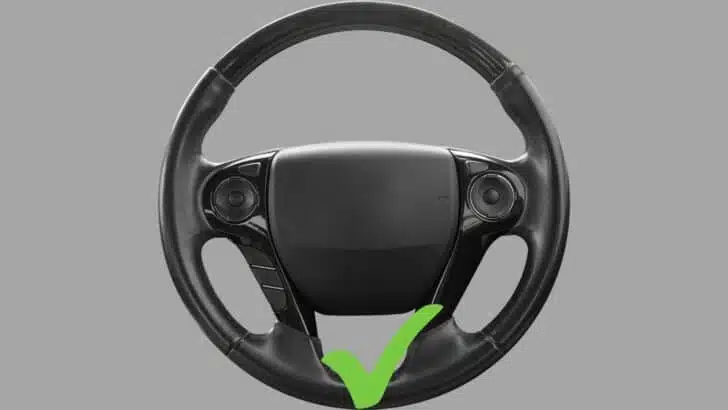
Holding the steering wheel at the six o’clock position while backing up a trailer is a great trick for overcoming the counterintuitive nature of backing a vehicle with a bend in it!
This eliminates much of the guesswork and helps reduce the tendency to saw the steering wheel back and forth when backing up. This makes it easier to back up any type of trailer, especially for new trailer drivers.
Take Your Time As You Learn How To Back Up a Trailer
Don’t rush. Slow Down. Take your time. I’m not sure how much more clearly I can express this — Allowing yourself to feel rushed or pressured is one of the worst things you can do.
Remember that anyone who successfully backs a rig into a campsite (or anywhere else) had to start somewhere. Until you’re the seasoned pro who impresses everyone in the campground with your backing prowess, you deserve the time to learn, too. It requires patience and concentration to avoid damaging the RV, and that’s okay. Don’t worry about other people; don’t let anyone else drive your rig for you!
Even if you notice people watching, don’t let the fear of embarrassment (or concern for what other campers may think of your driving abilities) affect you. In truth, they may be watching you for pointers because of their own anxieties when backing up their rigs.
Either way, ignore them, take your time, position yourself correctly, and back in slowly.
PRO TIP: Practice backing in a straight line first. Before you try backing around a corner into a campsite, start your practice time in the parking lot by backing up as straight as you can. Once you master keeping the trailer as straight as possible (and the subtle steering inputs required to do that), you’ll have a much easier time turning the trailer around tighter angles in more complex situations.
This is where you’ll see where the hand-at-the-bottom-of-the-wheel technique really helps. If the trailer starts to drift a little to the left, move your hand a little to the right, and it will aim the trailer back into line.
If it starts to aim to the right, move your hand a little to the left. Go slowly, and watch how small steering wheel movements affect the trailer’s direction. Use your side-view mirrors to see and learn when the tow vehicle and trailer are straight/aligned with one another.
And when we say “slowly,” that applies to two areas: Rolling slowly, so that you’ll have time to process and react to what’s happening, and turning the steering wheel slowly, too. New trailer drivers’ biggest mistake is rapidly sawing the steering wheel back and forth. Use small, slow movements, stop as needed, and process how those motions affect the trailer’s direction of travel.
One additional tip about this topic: moving the steering wheel while crawling backward will provide better feedback than turning the wheel while completely stopped. That’s because you can turn the wheel all the way from full right to full left lock while stopped, but that won’t provide any feedback about the effect it will have on the trailer… until you start moving again. And at that point, you may be heading the complete opposite of the desired direction.
By moving the wheel a little bit to the left or right as you roll very slowly, you’ll immediately see feedback in your side-view mirrors, showing you both the relative angle of the trailer to the towing vehicle and the direction the trailer is headed.
Also, shorter trailers and longer trailers respond differently, and each trailer requires different positioning. It may seem counterintuitive, but backing up a longer trailer is easier than backing up a shorter trailer (in one way, at least). That’s because the shorter distance between the pivot point (the hitch ball) and the trailer’s wheels causes smaller trailers to “jack” further and more suddenly with minor steering input.
Practice, practice, practice to learn how your rig responds to your inputs.
The following animation shows an example approach and entry into a typical back-in campsite. We’ll break down the process in step-by-step still images below, helping to explain each step along the way.
NOTE — Keep in mind that these images are simply examples of a typical campsite. Every situation will be different depending on the length of your rig (both towing vehicle and trailer), the width of the streets in the campground, and the angle of the campsite (some are perpendicular to the street, as in our example below, and some are sawtooth/angled, which makes backing in much easier!). You’ll need to adjust to each situation, but this is a good starting point for practice purposes.
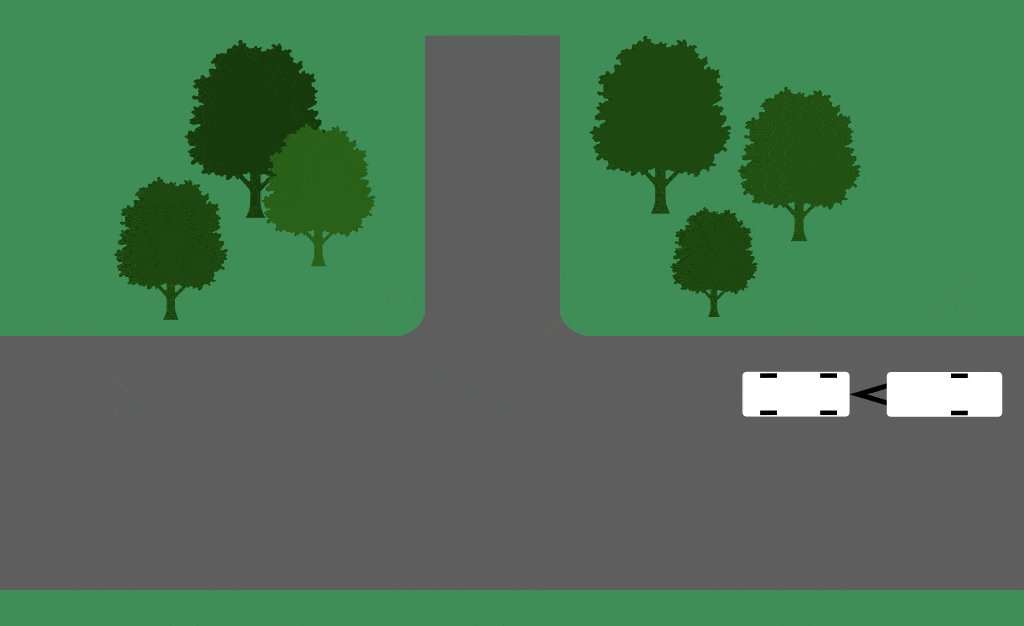
This animation shows an example approach and entry into a typical back-in campsite. Below, we’ll break down the steps frame by frame to explain what’s happening at each point along the way.
Prepare Your Approach to the Campsite
Now that we’ve covered the preparation for how to back up a trailer, let’s get to it. We’re going to stick with the “backing into a campsite” scenario since that’s usually the first and biggest challenge that most new trailer-towing RVers face when arriving at a campground.
Line up to back into a campsite by approaching the site on the side of the street that the campsite is on. Think about this: the wheels on your trailer don’t turn. If you want to aim your rig back into a campsite, you need to start by placing the trailer’s wheels near the entrance of that site.
For example, to set up to back into a campsite on your right side, stay to the right side of the road as you approach the site. For a campsite on the left, stay to the left side of the road as you approach. Obviously, we’re not talking about driving down the left side of a busy main street toward oncoming traffic. But staying to the left side within a campground shouldn’t be a problem, and is expected standard operating procedure to get parked in a campsite on the left.
You’ll also need to allow the most possible room to swing your towing vehicle out away from the site, toward the opposite side. Staying close to the side you’re backing towards facilitates this.
This is important because you need to position the wheels of the trailer so they’ll both line up more directly with the site and leave you room to maneuver your towing vehicle in the remaining space on the road. This will allow you to line the trailer up as straight as possible with the campsite before backing up.
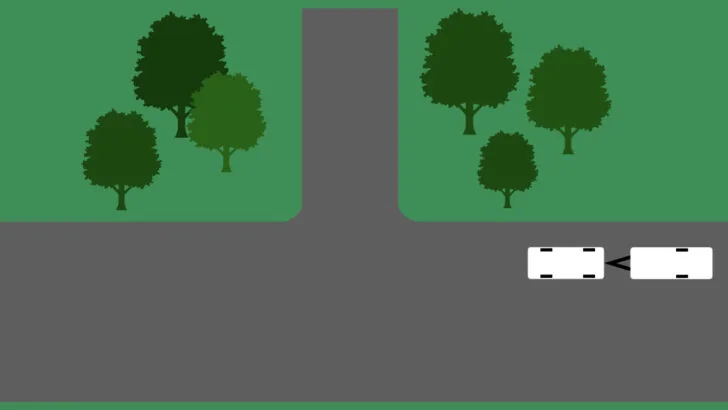
Here we’re driving through the campground, getting close to our campsite, up ahead on our right side.
Line Yourself Up as Straight as Possible With the Campsite
Align yourself with the site as straight as reasonably possible before backing in. Backing in as straight a line as reasonably possible helps make it easier to position yourself correctly in relation to the site (and see where you are while doing it).
In reality, you’ll almost never be able to get perfectly straight to the campsite before backing, because campground roadways are usually too narrow to allow that. You’ll almost always end up at an angle to the site. But two important tricks will help:
Pull Forward To The Correct Position and Get Set Up To Back Into the Campsite
This is probably one of the trickiest parts of the backing process to quantify. That’s both because every trailer is different, and because it’s impossible to see, (from the driver’s seat) precisely where your trailer’s wheels are lined up in relation to the campsite. The best way to practice (use your traffic cones in the parking lot to set up a “campsite”!) is to start by pulling straight forward along the “campsite side of the street” — let’s use the right side as an example, as shown in the graphic below.
Pull up until your trailer’s wheels are even with the near side of the site (in other words, the side you approached from). In our example of a campsite located on our right, that means pulling up right in front of the “parking lot cone-campsite” on your right side, and stopping when the trailer tires are even with the near side of the site.
Since you won’t be able to tell exactly where that is (even in the mirror or backup camera), either have a helper tell you when to stop… or GOAL!
You can also get a lot of benefit from trying to estimate when you think your trailer tires are even with the approach side of the campsite and then getting out to see how close you came. That builds experience, muscle memory, and confidence. Stop when you think you’re in the right spot, GOAL to see how you did, and use that information as you continue to practice. Each backing experience will build your expertise.
Once the trailer’s in position, cut your steering wheel hard to the opposite side of the street (to the left in our example of practicing on a campsite on your right side), and begin to roll to the left into the street. The objective is to end up with the trailer’s rear aimed toward the campsite’s entrance.
The positioning described here will usually come pretty close in most cases and will allow you to adjust as needed in future attempts (based on your rig’s length and configuration and how well lined up you were on this first attempt). Not far enough forward? Try pulling up until your trailer’s tires are in the middle of the campsite next time.
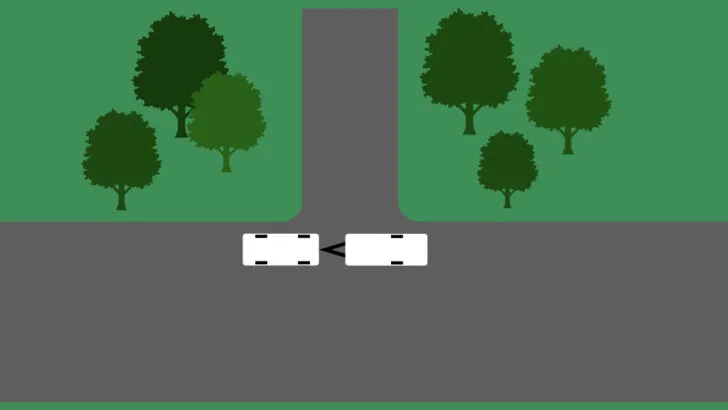
To line up with the campsite, we’ve positioned ourselves in two ways: 1) Drifted closer to the right edge of the roadway as we approached the campsite, allowing as much room on our left as possible to swing out and maneuver, and 2) Stopped with our trailer’s wheels even with the approach (near) side of the campsite.
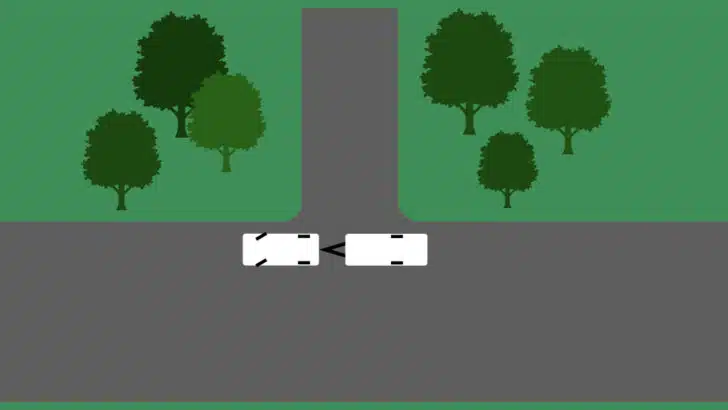
Once in position in front of the campsite, cut your wheels hard to the opposite side of the street. Turning the wheel can be done while completely stopped or while rolling VERY SLOWLY forward as you turn the wheel RAPIDLY. Rolling slowly while turning the wheel helps prevent scrubbing/wearing the tread of your front tires on the pavement. Turing the wheel RAPIDLY prevents you from making a wide arc when you want to be turning tightly.
Align/Straighten Your Trailer and Tow Vehicle Before Backing Up
As you follow the previous step in our example of backing into a campsite on your right side, you’re cutting your wheels hard to the left. But here’s the trick that takes some practice: knowing when to cut the steering wheel back the other way.
If you keep your wheels cut hard to the left and continue rolling forward until you reach the opposite side of the street, you will now be stopped with the trailer jacked hard to the left.
The challenge here is that beginning to back up with the trailer jacked hard to one side, as opposed to lined up straight (or straighter) with the towing vehicle, makes it more difficult to see behind you (remember that any position other than having the trailer straight with the tow vehicle completely hides one side of the trailer).
The other difficulty with beginning your backward movement toward the campsite with the trailer jacked hard to one side is how much more difficult that makes judging which way you’re heading/aiming. Backing and aiming the trailer where you want it to go is easiest with the towing vehicle and the trailer aligned as straight with each other as reasonably possible.
Here’s how to make the start of your backing motion easier: straighten up the tow vehicle with the trailer before beginning to back up. So rather than drive forward all the way to the opposite side of the street with the steering wheel locked to the left, switch to full-right steering wheel lock as you approach the opposite side of the street.
The trick here that takes practice is knowing how far across the street you should go before you reverse the wheel cut. How close should you be to the opposite side of the street?
We suggest you try starting out by leaving about 1/4 of the width of the roadway before switching the steering wheel to the opposite side. In other words, pull forward at full left lock until your front wheels are about 3/4 of the way across the width of the road.
Try different positions as you practice to see what works best for your rig and various road widths. (Keep in mind that the main factor here is the width of the campground roadway, so each situation will vary.) The wider the road, the easier it is to maneuver.
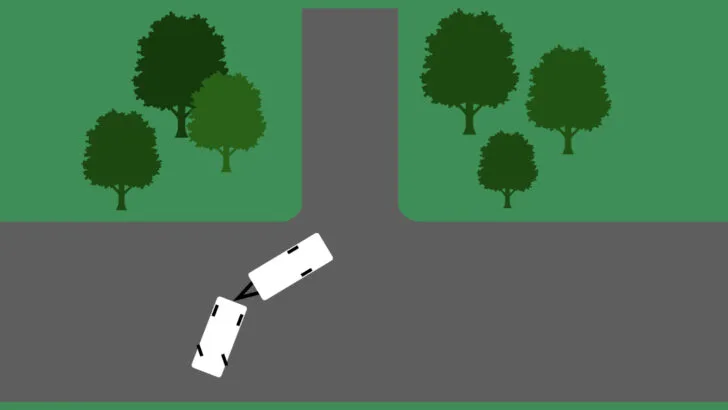
After cutting the wheels hard toward the opposite side of the street, we want to stop BEFORE we reach the edge of the road. Backing with the trailer “jacked” too sharply makes it harder to position ourselves accurately. The space we’ve left in front of us allows us to roll forward a little further to straighten the trailer with the towing vehicle.
At that point, come to a stop and cut the wheel to full-right lock (or a near-stop to avoid scrubbing the front tires on the pavement… just be sure to turn the steering wheel very rapidly while rolling very slowly).
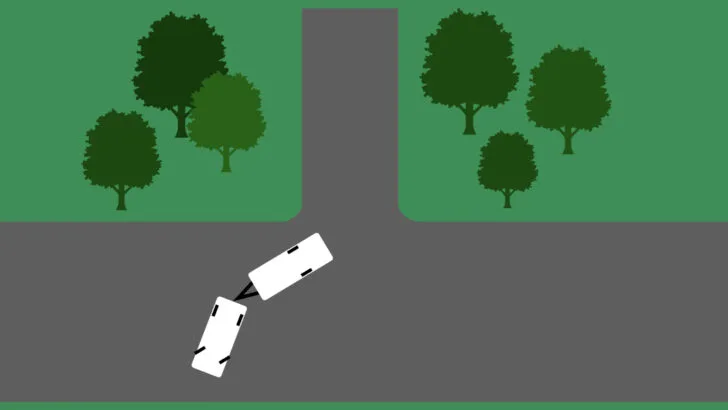
We now cut the steering wheel hard to the right, and prepare to pull forward, closer to the far edge of the roadway.
Now, continue to roll forward at full-right steering wheel lock. This will begin to “un-jack” the trailer, straightening it in relation to the towing vehicle. The straighter the two vehicles are to each other, the easier it is to see… and to aim the trailer as you begin to back up. If you’ve positioned yourself correctly, your trailer will be approximately aimed directly toward your campsite.
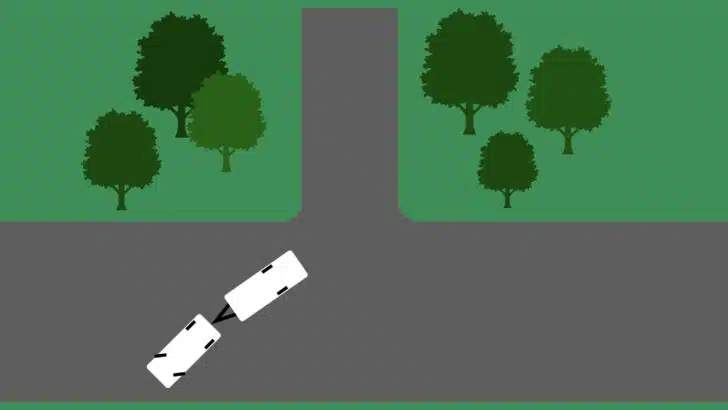
Now that we’ve pulled further forward with the steering wheel cut hard to the right, the trailer is better aligned with the towing vehicle, making it easier to direct the trailer in the desired direction as we begin backing up. This is where we stop, put the vehicle in reverse, and adjust the angle of our front wheels to begin backing up.
Once you begin to back up toward the campsite, you’ll quickly see how well you lined things up. Did you end up too far to the left or right to get parked in one shot? Try again, and adjust as needed. Each time you maneuver your trailer will add to your competence and ability as a trailer-towing RVer.
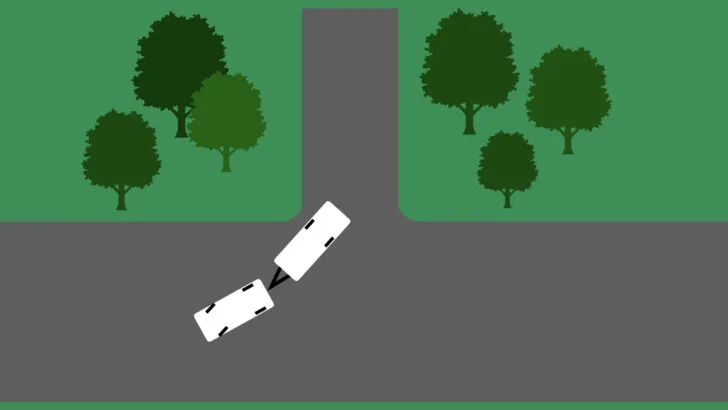
As you begin backing up, keeping the trailer as straight as reasonably possible with the tow vehicle, and avoiding dramatic sawing back and forth on the steering wheel will really pay off. That allows us to better see where we’re aimed and keeps us from getting crossed up with our steering input (as steering inputs are backward from normal).
Again, this all takes practice and varies based on vehicle size & length, roadway width, angle of the campsite, etc. This is why using traffic cones to set up a practice “campground roadway and campsite” in a large parking lot is so helpful. Seeing what works for your rig, and developing confidence and muscle memory, is what it’s all about.
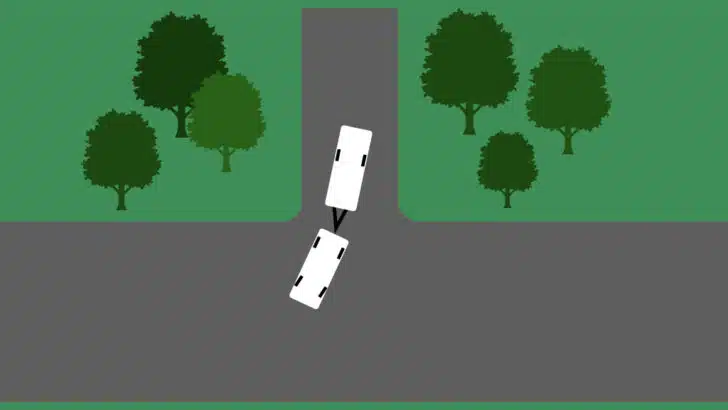
As you continue backing into the campsite (watching your mirrors, backup camera, and spotter) using a SLOW speed, and SMALL steering inputs, are the keys to success!
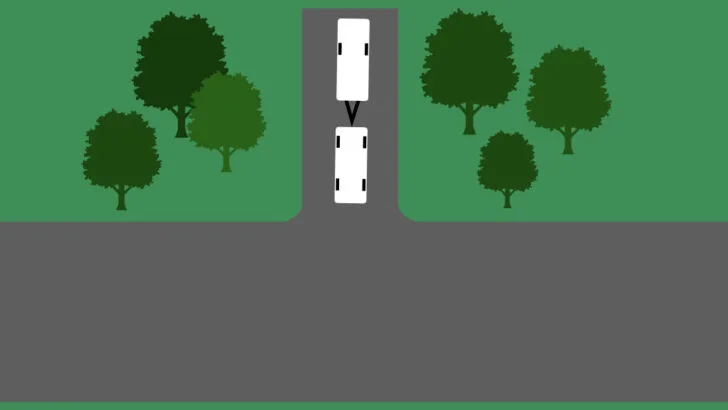
We’re in! Even seasoned RVers with lots of travel trailer towing experience will occasionally need a pull-up or two to re-position, especially in very tight conditions. But getting successfully backed into your campsite marks the start of a great camping trip.
PRO TIP: Know Your Vehicle Length in Paces
Learn the length of your vehicle in “paces.” For example, I know that 14 of my normal strides plus one foot, precisely equals the 43’ length of our Mountain Aire. This is especially helpful for determining if you’ll even fit into a site before you try!
With all of these tips in mind (and a little practice) you’ll be backing up any trailer like a pro in no time. Check out the following video for additional visual tips on how to back up a trailer.
Free RVing Tips, Tricks, Reviews & Giveaways
As 20-year full-timers, we share everything we’ve learned about RVing over the years. Join our online community to receive a wealth of great RVing knowledge delivered daily to your inbox.
Whether you’re a new RVer or a seasoned full-timer, you’ll love the wide range of RVing topics we cover. Don’t miss a single article or any of our famous Giveaways. Subscribe to our newsletter today!






Doreen
Monday 30th of October 2023
Great step by step description of backing up. I need to add this skill set for next spring’s camping season so hubby doesn’t have to always do it. A parking lot is in my future!
TheRVgeeks
Thursday 2nd of November 2023
Thanks, Doreen! We hope it helps... and have fun in the parking lot! 😉